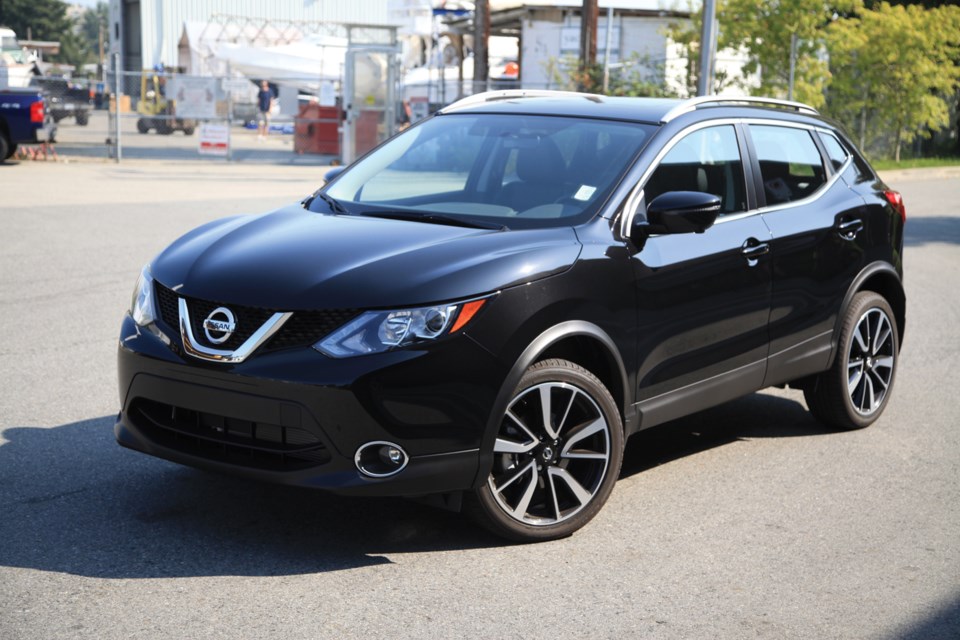Nissan didn’t have far to look for inspiration for its new compact utility vehicle.
The 2017 Qashqai gets some of its style – and its sturdy platform – from, you guessed it, the larger Rogue.
The Qashqai (pronounced cash-kye) has actually been around for more than a decade in Europe (the current body style launched there in 2013).
Why bring it here now? Because the surging popularity of small and tall wagons in North America means new opportunity.
How so? Where the Rogue is large enough to accommodate a third-row seat, the smaller Qashqai is not. For buyers who don’t need the space, the smaller and less-expensive Qashqai is a good fit. It’s also a good fit in urban areas where maneuverability and a smaller footprint for parking are welcome.
Viewed from the front, the Qashqai’s smaller V-Motion grille is a point of differentiation, but just barely as there’s only a hair’s breadth of difference in overall width between the two models. A lower (by 14 centimetres) profile and a 30.5-centimetre reduction in overall length places the Qashqai in a more compact segment along with the Honda HR-V, Mazda CX-3 and the new Toyota C-HR.
The distance between the front and rear wheels is nearly the same for the Rogue as the Qashqai, which means that rear-seat passengers are at least afforded a decent amount of leg and knee room and only the tallest of them will experience any headroom issues. There’s also plenty of people space up front where the busy-but-attractive dashboard is a near copy of the Rogue’s, right down to the gauges, switches, touchscreen and vent outlets.
As for cargo volume, the Qashqai lags behind its larger sibling, but not as much as you might think, especially with the second-row seat folded flat. In terms of room, the Qashqai is out front in its class.
The engine? Not so much. The Qashqai has a 2.0-litre four-cylinder that generates 141 horsepower and 147 foot-pounds of torque. The bigger Rogue’s 2.5-litre four-cylinder makes 170 h.p. and 175 foot-pounds of torque. The 2.0 is by no means a speed demon, but it will be sufficient for most buyers in a stop-and-go urban environment. But since the Qashqai weighs only about 100 kilograms less that its bigger sibling, the 2.0 does have its work cut out for it.
A six-speed manual transmission is exclusive to Canada, while Nissan’s Xtronic continuously variable transmission (CVT) is available. In the United States, where the same vehicle is being sold as the Rogue Sport, buyers only get the CVT. As with most other wagons in this category, the Qashqai can be had as a front- or all-wheel driver.
Fuel consumption is OK at 8.8 (litres/100 kilometres) in the city and 7.3 on the highway for the front-wheel-drive model, and 9.1/7.5 if all-wheel drive is specified. The highway numbers are actually slightly worse than the Rogue’s, which suggests that the Qashqai is under-engined for its weight.
One promising aspect to the Qashqai’s performance is the four-wheel independent suspension’s competency over a variety of road surfaces and during cornering. A quiet, comfortable cabin environment at speed is also a plus.
Qashqai pricing starts at $22,000 for the base S ($2,000 more for AWD versions) and includes the standard items, while the SV trim adds dual-zone climate controls, power moonroof, under-floor storage system and 17-inch alloy wheels (16-inch steel wheels are standard).
The top-end SL comes with leather-covered seats (heated in front), navigation, 17.5-centimetre touch-screen, 360-degree Around-View Monitor and 19-inch wheels. Ordering the SL is the only way to tack on the active-safety suite of technologies that prevents collisions with other vehicles and pedestrians.
With the significant $5,250 base-price gap between the Rogue and the Qashqai, the idea is to bring in new buyers to the brand as well as provide a smaller and lower-priced utility vehicle for owners of Nissan’s smaller cars to move into.
No matter where buyers come from, the Qashqai’s class-leading size and styling should make it a fresh-out-of-the-box hit.
Market position
Car-based tall wagons of every size and description are growing more popular than traditional sedans (such as the Sentra and Maxima), which is exactly why Nissan has brought the Qashqai to the Canadian market.
Points
• Rather than create a fresh look, Nissan stuck with the global design that’s nearly five years old.
• Being one of the more spacious wagons in its class will be a sales boon.
• Standard-issue engine could use a power/efficiency boost.
• Sensibly priced and optioned trim levels.
• Think of the Qashqai as a five-passenger version of the seven-passenger Rogue.
Active safety
Blind-spot warning with cross-traffic alert; active cruise control; emergency braking; pedestrian alert (all optional).
Competition
Honda HR-V: Small but versatile model offers great fuel economy from a 141 h.p. engine. Base price: $22,850.
Mazda CX-3: More sporty than spacious, but looks great and is equally great fun to drive. Base price: $22,000.
Subaru Crosstrek: Attractively priced model comes with standard all-wheel drive. Base price: $25,400.
wheelbasemedia.com



